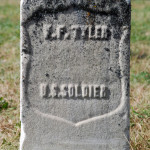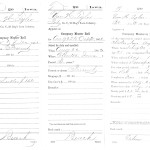Van Tyler served and survived in the Civil War, but succombed to the “enemy within,” Soldier”'s Heart.
By Sue Hunter Weir
Emma Tyler thought that her husband was going to kill her. He”'d said so, and she believed him. So on the morning of Saturday, October 14, 1893, she went to see Minneapolis”' Chief of Police to get help. She told the chief that her husband had been stalking and threatening her. Chief Vernon Smith sent her away after promising her that “Barking dogs don”'t bite.” He was wrong.
At one o”'clock that afternoon, Van Tyler fired three shots at his wife with a 22-calibre revolver. Two of the bullets struck her. He then turned the gun on himself. Emma Tyler survived the assault but her husband did not.
Vincent “Van” Tyler was a Civil War veteran and, according to his military papers, he was steady and reliable. He enlisted in Company C of the 20th Iowa Volunteer Infantry on August 12, 1862. He was promoted to corporal and served until July 8, 1865. He was a good soldier but his domestic life was another matter.
Emma and Van Tyler were married in a Baptist church in Oshkosh, Wisconsin, on December 31, 1879. He was 41 years old, just four years younger than her father; Emma was 20. She was Tyler”'s third wife. According to Tyler”'s brother, Horace, the first marriage fell apart because Tyler”'s wife was unfaithful and he “was wrecked financially through her extravagance.” His second marriage was supposedly a happy one, but his wife died not long after giving birth to their son. At the time of the shooting Tyler”'s son, who was about twelve years old, was living with Tyler”'s sister in Iowa. Despite the fact that Vincent and Emma had been married for ten years at the time of the shooting, his family in Iowa and his son had never met her.
We have no way of knowing what Tyler was like before he served in the war. Different people described him differently and each of those accounts may well have been true. What is known is that the Tylers had been having marital problems and separated a few months before the shooting.
H. L. Kinkel, janitor of the Myers”' Block apartments, said that Emma Tyler had told him that her husband “”¦was a man of very dissipated habits and that she had been compelled to leave him.” Tyler had sold all of their furniture, she said, and used at least some of the money “for drink.” He used the rest to go to Iowa to see about buying a farm. While he was gone, Emma went into hiding. She went back to using her maiden name and moved into a third floor apartment with her sister, Jennie.
When he returned from Iowa, Tyler was short on cash. He went to visit his former boss, Czar Payne, who owned a grocery store. Payne thought very highly of Tyler. He, too, described him as “steady and reliable” and tried to help him out by paying him to do odd jobs around the store. Early on Emma had been in the habit of stopping by the store around closing time and waiting for her husband to get off work so Payne assumed that they were happily married, but Payne admitted that lately he”'d had cause for concern about Tyler”'s behavior. On the day before the shooting, Tyler had shown Payne a box of cartridges that he”'d bought. According to Payne, Tyler was “unusually downcast and quiet” and seemed to have “something of a serious nature on his mind.” On the morning of the shooting Tyler stopped by the store again and Payne was relieved to see that he was in much better spirits.
Before he”'d returned to Minneapolis Tyler had written to Emma asking her to join him in Iowa. She refused. He had come back to press his case but without any luck. At some point, he seemed to accept the fact that Emma did not intend to move to Iowa and told Payne that he was willing to live in Minneapolis if that is what Emma wanted. What he couldn”'t seem to accept was that Emma had no intention of living with him at all.
Emma was a small-town girl who had found a glamorous job in a big city. She worked as a seamstress for the Smith Costuming Company, a company that rented and sold fancy costumes for theatrical and operatic performances, and for carnivals and masquerade balls. It was a world populated with interesting people decked out in sequins and silks, one that was far away from the farm where she grew up. If Emma felt that she had not seen enough of the world, after four years in the service Tyler may well have felt that he”'d seen more than his share.
On the morning of the day of the shooting Tyler went to the apartment building where Emma was staying with her sister. She refused to let him in. Tyler left but returned to the building a short time later; by then Emma and her sister were gone””they had gone to see the Chief of Police.
When the two women left the police chief”'s office Tyler was waiting for them at the corner of Third Avenue and Fifth Street. He approached them and announced his intention of going back to their apartment with them. When Emma told him no, he grabbed her arm and struck her in the head. She struggled, broke free, and started to run. Tyler drew a 22-caliber revolver and fired at her three times. One of the bullets struck the end of her nose, entered her sinus cavity and passed into her throat. Another bullet struck her in the back of the head and lodged in the bone there. The third shot missed her. Bleeding profusely, Emma managed to run into Johnson & Hurd”'s lumber mill with Tyler chasing her. She fell to the floor and reportedly screamed, “Oh God, forgive me for my sins.”
The shooting had drawn a crowd, and Tyler was trapped, although given what he did next, it is doubtful that he intended to run away. He put the revolver to his own head and pulled the trigger. The gun misfired, so he tried again. His gun misfired a second time. Tyler put a new cartridge in the gun and fired one last time. The new bullet struck him in the head, wounding but not immediately killing him. He was taken to the City Hospital in a police patrol wagon and died later that night without regaining consciousness.
No one stepped forward to claim his remains. Officers of the Grand Army initially expressed doubt that he was a veteran and refused to bury him. They were obligated to do so after Tyler”'s family provided them with copies of his discharge papers. Vincent Tyler is buried in the first row of the Grand Army of the Republic plot near the Lake Street gates.












